The books transported her into new worlds and introduced her to amazing people who lived exciting lives. She went on olden-day sailing ships with Joseph Conrad. She went to Africa with Ernest Hemingway and to India with Rudyard Kipling. She travelled all over the world while sitting in her little room in an English village.
Roald Dahl, Matilda
Perhaps the greatest son of both Norway and Great Britain (he was more Welsh than English), the author Roald Dahl, could take readers across the world through his magnificent prose. This Thursday evening the daughters of each nation will instead ascend to the pinnacle of women’s world football when they face one another in a much-anticipated quarter-final.
In this tactical analysis, we shall see how Norway will hope to further refine the speed of their attack by pushing Caroline Graham Hansen further forwards. In turn, England will hope to congest the centre to prevent this area from gaining significance. Furthermore, they will, in turn, try to overcome the abiding defensive lines of Norway’s flexible defenders. If England are to have any chance in piercing Norway’s defensive tactical fluidity, they will have to get the most of their wide players but in a manner that hasn’t totally paid off in the tournament, so far.
Tactical analysis: line-ups and shape
Norway went into this World Cup with a 4-4-2 which transitioned into a 4-2-2-2 when attacking. Against one of the tournament’s top sides, however, it feels almost certain that Norway will adopt their more recent 4-5-1 starting stance. They notably first tried this when they played France in Group A. Against Australia though, they were in a much more defined 4-4-1-1 or 4-1-3-1-1.
In this shape, Ingrid Engen looks to sit much deeper, where she matured into a reliable figure on the ball. Always looking to tease Australia onto the front foot, she offered a composed target through which to pass to in order to dismantle the Matilda’s press. Vilde Bøe Risa then staggered herself from Engen, and it was this shape which allowed them to keep pushing further forwards.
From here, Norway can attack with many options but still retain a defensive precautiousness. Balls can be played to the overlapping full-backs, to Karina Saevik who positions wide before mercilessly slipping into the centre to bolster Graham Hansen, or even something a bit longer to Isabell Herlovsen, who likes to move into the channels. Personnel-wise, Norway will seek to be unchanged. Martin Sjögren’s faith in his core group of players is crucial in his decision-making over his starting formation.
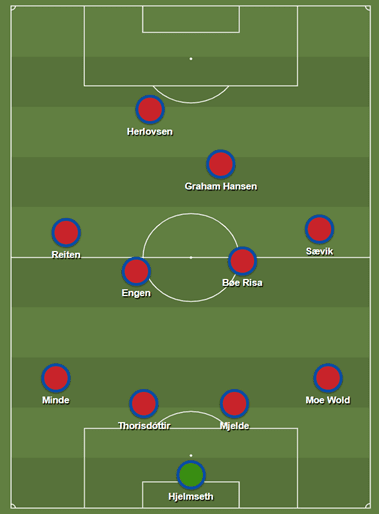
Phil Neville has been rather different to Sjögren in that he’s sought to use a larger variety of his squad, as well as changing formation several times. Due to the dangers which Norway provide, we should expect England to line up in the 4-2-3-1. This should provide attacking as well as defensive solidity. Likewise, Norway notably stuttered when they last played France, who adopted this shape.
With regards to his starting XI, Neville has been open about how he sees his side as having multiple personalities and he will chop-and-change to suit his ideal gameplan. Following the round of 16 victory over Cameroon, amongst his more controversial remarks, he stated, “that’s what rotation is about, not about putting 23 players into a hat and picking out 11 – we strategically plan each rotation and made eight today.”
As we come to the business end of the tournament, however, it seems likely that the England gaffer will finally have to settle on the squad. If nothing else, the homogenisation of opposition quality will mean that he’ll need to focus more on a plan A than being able to vary his attack. Whilst The Times have reported how Steph Houghton and Millie Bright could be ruled out due to injury and illness respectively, we’ll assume that late fitness tests will be passed.
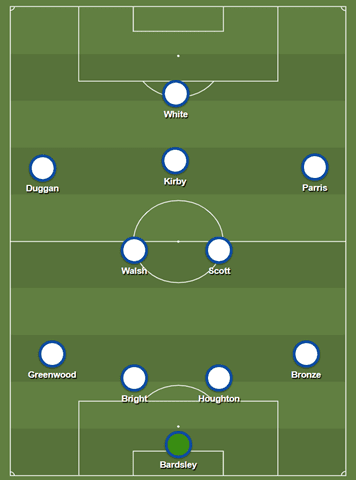
Norway speeding up their attack
From their Group A matchup against France, we discussed how the Norwegian side looked to speed up the stages of their attack. If we were to break down how Sjögren gets his side to play, we can see that when deploying his usual 4-4-2, Norway have roughly three stages of play.
Norway usually enjoy a patient build-up play, even when faced with a high press from their opponents. This was seen against Australia, as the intricate and complementary movements of Engen and Bøe Risa proved to be enough to move past these blocks. This is proven when we look at the statistics, where we can see despite the high block, Norway still managed a relatively high number of passes per defensive action (7.2).
The second phase of their play usually morphs into passes into the wide players, either the full-backs pressing slightly higher or the wingers. The wide players would tuck inside, and then allow for passes to the front two, or knockback to the wing-backs who’ll provide a cross. In the below, we can see how against Australia, Norway attacked in numbers. The ball comes through the middle but is passed out wide.
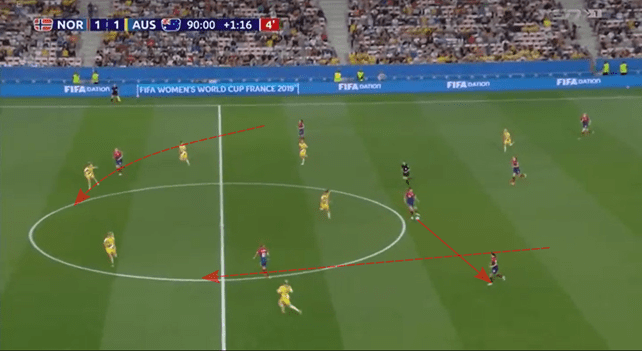
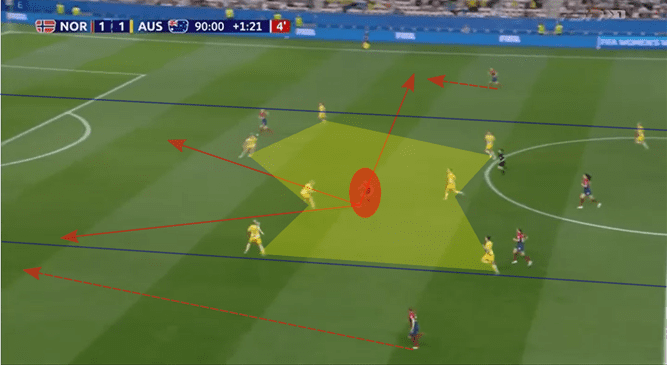
In the 4-4-1-1, however, Norway essentially bypass the need to knock the ball out wide deep in their own half. By moving the ball forwards to Carolina Graham Hansen, who plays as an attacking midfielder, just off of Herlovsen, Norway find themselves nearing the final third with an attacker ahead of them, two full backs on either side, as well as two wingers. The series of graphics pictured features Guro Reiten taking this role. If anything, however, this is only another headache for England: Norway’s utilitarian-style of play.
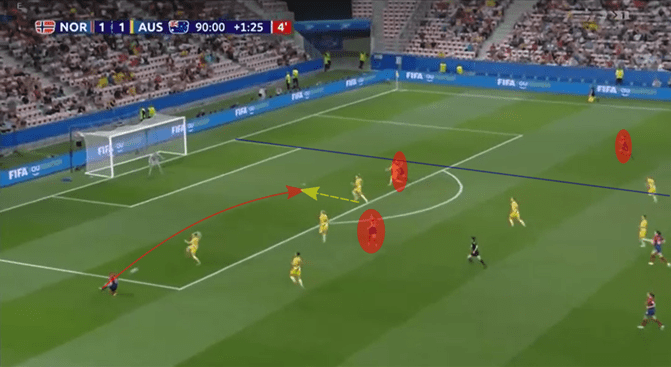
The general increase in Norway’s attacking pace is palpable, and in all fairness, largely explains why they looked so potent against the Australians. Admittedly, Australia were prone to overcommitting, but undue credit was made to the role Hansen played. Against France, when this style of play was in development, noticeably 100% of Norway’s attacks came from the middle of the pitch.
England optimising the centre
Without a doubt, if Phil Neville’s side are to have any chance of conquering the Norwegians here, they must find a way to clog this hole in the middle of the pitch. An essential element at the heart of the England team is Jill Scott. Scott, who’s had an excellent albeit unfrilly tournament so far, could be essential if this is to be the case.
The Manchester City star is a fantastic number eight, just as capable of driving the ball forwards with nonchalant grace, as well turning into a wrecking ball and smashing into opposition counter-attacks. With regard to stifling Hansen, however, she is the perfect candidate to carry out some kind of Paul Lambert-on-Zinedine Zidane hatchet job, a la the 1997 Champions League Final. Few can look past Scott as crucial in breaking up opposition momentum and reigniting England attacks.
With the question being where Scott should position herself to best ward off Hansen’s threat, we need to ask whether man-marking is a viable option? Perhaps surprisingly, the answer would be no. Two reasons for this spring to mind. The first is that against France, we saw Hansen usually emerge from the right-wing when Norway broke forward. To draw Scott out of a central position would leave a perilous gap in the middle of the field, one which Norway could bypass with ease.
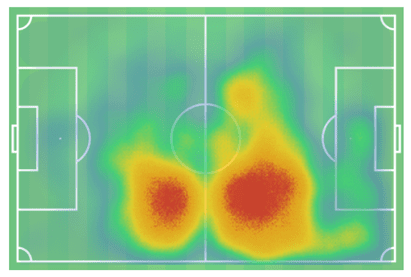
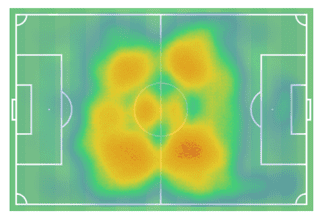
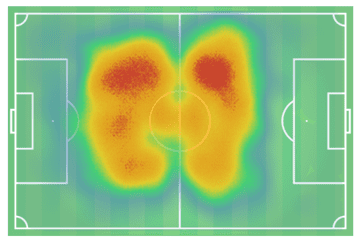
The second reason is that Neville will have to balance his hyper-anxiety of a Norway lightning counter, over his own desire to pen the opposition within 10 yards of their own penalty area. To not allow Scott to contribute would withdraw one of England’s most understated attackers.
Rather, it appears that Keira Walsh will be much better taking on this role, as she sits deeper. Scott and Walsh will need to double up to emulate Amandine Henry. Against Norway in the group, the French captain was magnificent in containing the attacker. The heat maps above show how Walsh perhaps best matches Henry’s usual movements. By committing Walsh to mark Graham Hansen, England can stub out Norway’s most potent attacking threat.
Norway’s defensive Dudeism
Sjögren has been largely underestimated as a master tactician going into this tournament. The disaster that was his first major campaign, the 2017 European Championships, has largely healed yet even by this stage in the competition, few see him as doing anything other than tapping into a highly proficient outfit.
The team is talented, unquestionably. At the same time, however, they’re also highly dependent on some very astute tactical decision-making. One thing that is startlingly refreshing is that whilst they have an attacking playbook to rival the New England Patriots’, in defence they are also just as happy to press high and pummel deep-lying midfielders, as they are to sit deep on their own penalty area and crowd out their opponents.
An excellent case in point of this is the average positioning of the ever-present left-back, Kristine Minde. The Wolfsburg wing-back has, this season on average, taken much higher positions up the pitch. Compare this, however, with her positioning in this World Cup. The below heat maps show a significant difference:
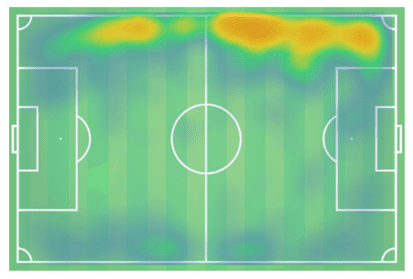
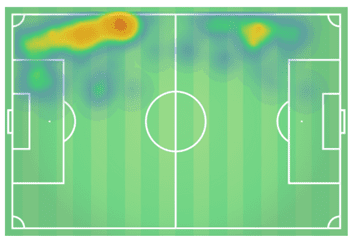
There are a few reasons why Minde is happy to sit deeper. One is that Norway defend with a curtain-like defensive line. When the full-back closest to the ball advances, the other simply drops level with the defenders and shimmies across. This provides adequate defensive cover on the immediate vulnerable side, allows for enough players to be behind the ball in the event of a counter, and also reduces the gaps within the half-spaces, where Norway look most vulnerable. This is seen below:
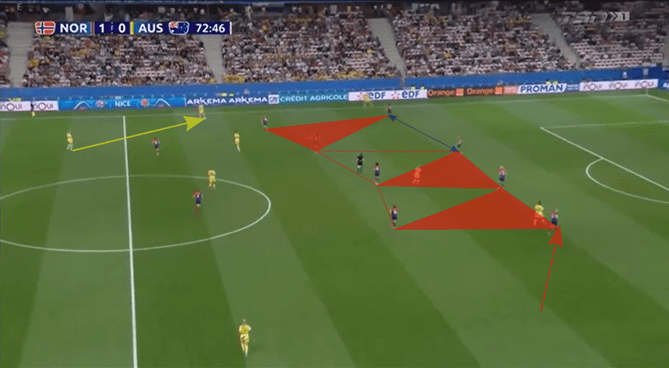
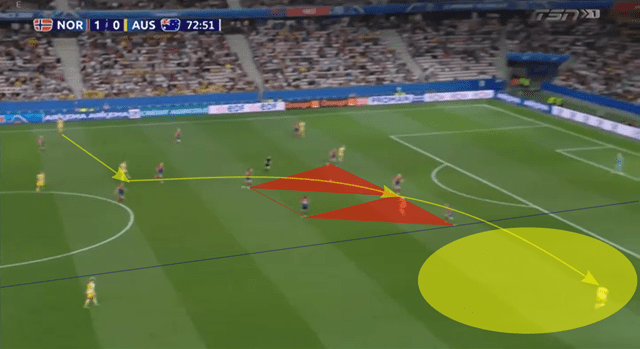
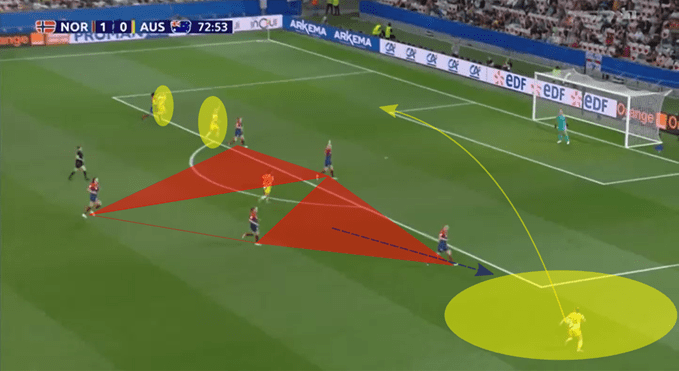
Likewise, the above graphics also show how Norway’s defensive patterns do have some fragilities. Whilst they do draw defenders across to cover, the full-back closest to the ball is prone to being dragged out by a wide playing attacker. Likewise, ample space is always available on the outside. This is a case of damaged limitations, and preserving the integrity of the half-spaces but at the same time, wingers are afforded with an awful amount of space.
England attacking these wide areas
The question there becomes how can England best counteract this? A tactical analysis will show that England need to favour a good switch of the ball. If we observe the below pass maps taken from their group game against Argentina, we can see how invaluable the left-winger, Beth Meade, became when switching play. Naturally, if the English left-wing is to be the main outlet for their advancements, the vulnerable target will be Ingrid Moe Wold.
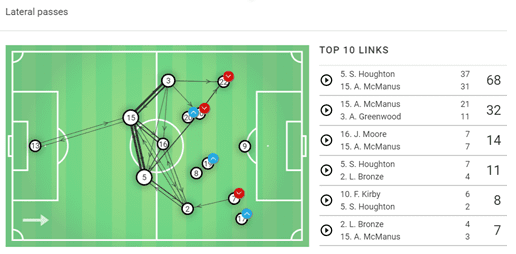
But this is not to say that the English will only have one ace up their sleeve. Of course, the right side of England’s attack is usually seen as their main strong point with Nikitta Parris and Lucy Bronze manipulating play and creating overloads time and time again. With their defenders remaining in a withdrawn position, Parris may struggle to get behind but we can then see two potential areas where England can attack: the half-spaces between the full-backs and centre backs, as well as through the attacking centre.
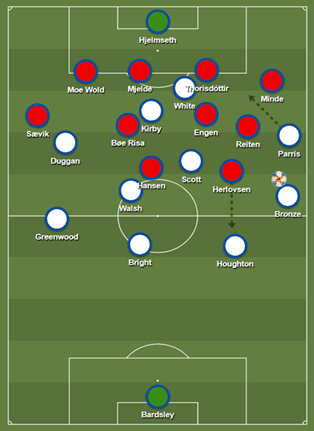
Norway will need their wingers to withdraw and offer an almost concertina, zigzag defensive block if they are to both occupy their markers and cover passing lanes. The quagmire will halt England in their tracks. If Norway do remain deep, however, Parris must move beyond her marker and make Bronze the lead ball-player.
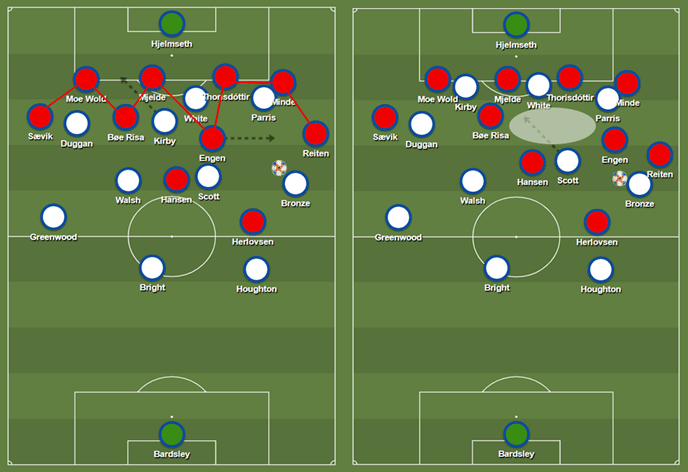
This will draw Bøe Risa and Engen into the flank areas and open areas in the middle for Kirby and Scott to drive into. If these areas are also congested, for instance, with Hansen withdrawing, we should expect to see switches of the ball. This is how best to keep Norway scrambling and has been underutilised in the tournament so far.
The important point is to prevent Norway’s serial-headers, Maren Mjelde and Maria Thorisdóttir, away from having any chance of clearing the ball. Tease them from their positions with angled passing, but let the ball drop shallow enough to stop them getting near it. If space is available on the left side, Moe Wold will struggle against the technical superiority of Toni Duggan. Likewise, with Alex Greenwood in support and available for overlaps, England will seek to move the ball quickly and threaten overloads.
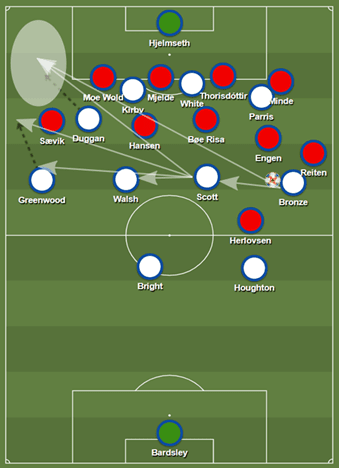
Conclusions
Perhaps this comes from a place of bias but Norway have been one of the most exciting sides to watch in the tournament so far. Their games against France and Australia were peak emotionality combined with tactical dexterity. England, on the other hand, hold a weight of expectation that they should be the team to watch. Ultimately, however, they haven’t really got going as of yet. This game could be pivotal in deciding the winner of the FIFA Women’s World Cup.
This could be the game where Neville’s side finally mature and hit their groove in the competition. Against a side well drilled, the pre-tournament dark horses to advance, they need to. We’re predicting that this will be a nail-biting encounter. Norway will aim to add further refinements to their system revolving around Graham Hansen’s advanced attacking role. England, having already seen this tactic attempted twice now, will need to clog this hole. Switches to either flank will be their order of the day. Will it be enough? It should be. But underestimate the tactical boldness of either of these teams at your peril.
If you are following the FIFA Women’s World Cup 2019 then you will find our FREE tactical preview magazine the perfect compliment to the tournament. You can download it HERE – each nation is previewed and we also profile their key player and young player to watch. Enjoy!

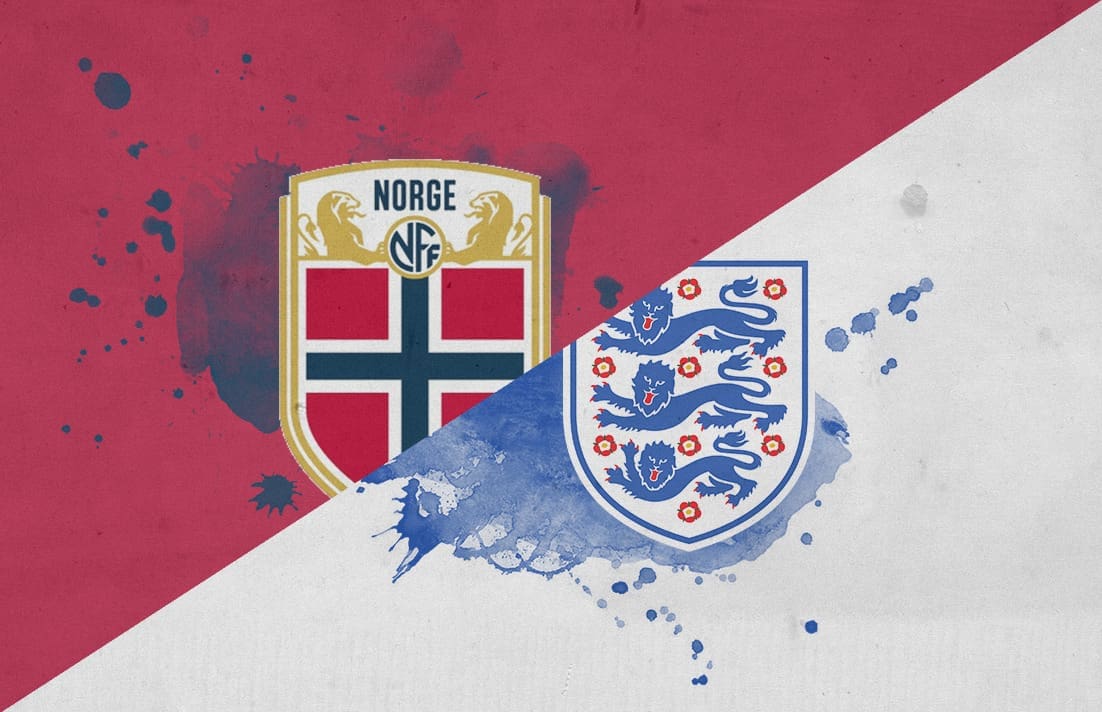



Comments